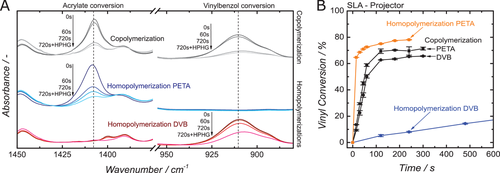Researchers are getting even more in-depth with the study of materials and 3D printing with metal in the recently published, ‘Activated Carbon in the Third Dimension—3D Printing of a Tuned Porous Carbon.’ Seeking to create hierarchically structured porous carbons, the team of scientists from Technische Universität Darmstadt experimented with SLA 3D printing to create a new form of mechanically stable structures.

Schematic overview of the 3D printing process, starting from the liquid photoresin, then producing a porous polymer open cell structure (tetragonal unit cell) by stereolithographic 3D print and subsequent extraction of the porogen phase, finally yielding an activated carbon open cell structure upon a thermal treatment consisting of stabilization in air, pyrolysis in nitrogen and activation in CO2.
Usually obtained in the form of powder, carbons may be classic black, activated, or nanomaterial. Often though, conductivity levels in these types of powder are low—causing ohmic losses and more constricted functionality for applications where more high surface area carbons are useful, such as:
- Electrical
- Solar energy conversion
- Energy storage
- Gas separation
- Storage
- Waste-water treatment
The scientists expect that disadvantages with carbon materials can be overcome with the use of structures like monoliths, foams, and ‘regular open cellular structures.’ For structures requiring flexibility, on the other hand, other techniques can be employed like electron or laser melting, SLA, FFF 3D printing, and more. Previously, direct ink writing has shown great potential with graphene, but to improve control regarding porosity issues, the researchers endeavored to tune structures ‘on several scales.’
Printing a macroscopic structure, the researchers performed several steps, beginning with SLA 3D printing to control the part, while adding liquid porogen to cause phase separation and form a template. Once that is extracted, the polymer is stabilized with oxygen curing and then the final step of being pyrolyzed.
“In the final CO2 activation, the microporosity of the resulting carbon structure can be increased,” stated the researchers.

A) IR Spectra of photoresins containing 50% DEP as porogen and either 50% DVB, 50% PETA, or 25% DVB plus 25% PETA, after different illumination times in the 3D printer; B) Conversion of aromatic and acrylic vinyl groups as a function of illumination time in the 3D printer for the homopolymerizations of DVB or PETA and the copolymerization of DVB and PETA together with 50 vol% DEP as porogen.
As the polymer is converted to carbon, the initial shape should still be maintained. The research team states that first a suitable monomer must be found. In this study, the three different monomers originally used were not suitable for the ‘envisioned synthesis strategy,’ however, a co-polymer made up of both an acrylate-based monomer and an aromatic monomer, yielded ‘synergistic effects.’
It was critical in the study, and resulting process, that copolymerization occur during photopolymerization—from within the SLA 3D printer, representing the only route for the slow-reacting DVB to be integrated. The researchers also stated that within this research they were not seeking parallel homopolymerization as it would separate the polymers and cause negative repercussions during pyrolysis.
“This new and flexible approach to hierarchically structured carbon materials paves the way to identifying and applying optimized carbon materials in various applications,” stated the researchers. “Applications in which the connected structure can be leveraged, e.g., due to higher electrical or thermal conductivity, stand to benefit: computer optimized electrodes in electrochemical applications are a very promising field.”
While researchers for this study may have delved into more complex ways to create structures from carbon, many other uses have been discovered too, from carbon nanotube inks to carbon fiber composites, and even shape memory composites. What do you think of this news? Let us know your thoughts! Join the discussion of this and other 3D printing topics at 3DPrintBoard.com.

A,B) SEM images of a carbon spiral that was 3D printed with a dye concentration of 0.8 mg mL−1 and a layer thickness of 20 µm; C) Carbon open‐cell structure based on a tetrahedral unit cell and 3D printed with a dye concentration of 0.4 mg mL−1 and a layer height of 100 µm supporting the weight of a 1.7 kg steel cylinder.
Subscribe to Our Email Newsletter
Stay up-to-date on all the latest news from the 3D printing industry and receive information and offers from third party vendors.
You May Also Like
World’s Largest Polymer 3D Printer Unveiled by UMaine: Houses, Tools, Boats to Come
The University of Maine has once again broken its own record by unveiling the largest polymer 3D printer in the world. Surpassing its 2019 achievement, the new Factory of the...
Changing the Landscape: 1Print Co-Founder Adam Friedman on His Unique Approach to 3D Printed Construction
Additive construction (AC) is much more versatile than it seems, at first: as natural as it is to focus on the exciting prospect of automated home construction, there’s far more...
Gorilla Sports GE’s First 3D Printed Titanium Cast
How do you help a gorilla with a broken arm? Sounds like the start of a bad joke a zookeeper might tell, but it’s an actual dilemma recently faced by...
3D Printing Webinar and Event Roundup: April 21, 2024
It’s another busy week of webinars and events, starting with Hannover Messe in Germany and continuing with Metalcasting Congress, Chinaplas, TechBlick’s Innovation Festival, and more. Stratasys continues its advanced training...





























